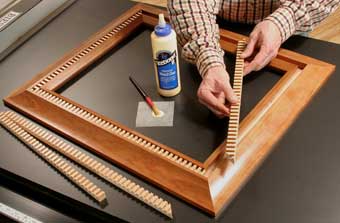
I’m relatively new at woodworking; one thing that I’ve not found in any of my references so far regards mitering for picture framing, though I’m quite sure it’s been asked and answered more times than I can count. What is the math one uses to calculate the overall length of the individual pieces? – Tim Cannon
Tim Inman: Build the desired “total length” out from the “known” dimension – the mat or the artwork – which must lay in the rabbet of the frame. I most often build up a “mock construction” or a model to measure from and do my layouts. I find this test piece a much more reliable assistant than my calculator.
Chris Marshall: I agree with Tim; it never hurts to create a prototype of your frame first. To size a picture frame, you have to start with what you want the inside opening of the frame to be. Then, consider what you have on each end of the four frame pieces: an isosceles right triangle where the hypotenuse is the 45° mitered edge. What does this mean? Well, the width of the frame piece equals one of the triangle’s two matching sides. So, once you determine the length of the inside edge of the frame piece, just add twice the width of the frame stock to this measurement: you’re adding on those two outside legs of the triangles, which of course match the width of the frame piece (the other matching legs of the triangle). Then, give yourself several more inches of extra stock when preparing the frame pieces so you won’t come up a tad short when mitering the pieces to length.





